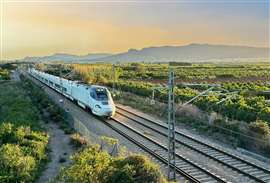Spain’s high rollers vie for high-speed rail contract
10 October 2023
Spanish railway administrator Adif has received bids from ten companies vying to construct a major section of the Cantabrian-Mediterranean high-speed railway corridor.
 After China, Spain has the world’s longest high-speed rail network. Photo: Adobe Stock
After China, Spain has the world’s longest high-speed rail network. Photo: Adobe Stock
The €282 million project will include the construction of the railway from Tafalla to Campanas in the region of Navarre.
In August, Adif initiated the tender process, setting a base budget of €232.7 million (excluding taxes). Of the ten bids submitted, nine came from temporary joint ventures, plus one from Vías y Construcciones, a subsidiary of ACS, one of Spain’s largest construction companies.
The JV tenders were:
- Sacyr in partnership with OHLA;
- Acciona and Sando;
- FCC and CYCASA Canteras y Construcciones;
- Rubau, ASCH, Altuna y Uria and Contratas Vilor;
- Dragados (ACS), Obras Especiales and TECSA;
- Azvi, River Infraestructuras and GEOTUNEL;
- Ferrovial, COMSA and Nortunel;
- Copisa, Lantania and Aldesa;
- COPASA, Grupo Puentes, Grupo San José, and Lurpelan.
The initial review of bids was based on solvency criteria and all ten bids were deemed eligible.
The second review, based on criteria evaluated by formulas, revealed that COPASA, Grupo Puentes, Grupo San José and Lurpelan JV gained the most points, totalling 46.76.
Acciona-Sando followed closely with 44.65 points and Sacyr-OHLA secured 44.14 points, according to documentation published on the state contracting portal by Adif.
From an economic perspective, there is little variance in the bids, with the lowest submitted by Azvi, River Infraestructuras and GEOTUNEL, jointly offering €192.57 million.
The highest bid came from the JV comprising Ferrovial, COMSA, and Nortunel, at €198.2 million.
The project encompasses the construction of three tunnels measuring 474m, 658m and 506m, as well as a 546m viaduct and various overpasses and underpasses.
Adif said the project will “consolidate a new railway connection, reinforcing passenger and freight mobility in the region of Navarre.”
The new railway section will cross seven municipalities: Tafalla, Pueyo, Garínoain, Barásoain, Tirapu, Biurrún-Olcoz, and Tiebas-Muruarte de Reta.
Significant addition to the network
The Cantabrian-Mediterranean Corridor is a significant component of Spain’s railway network, intended to connect the Basque Country and Cantabria with Valencia.
It was initially announced in 2004 by the then minister of public works, Magdalena Álvarez, and later incorporated into the 2005-2020 Strategic Infrastructure and Transport Plan.
The project aims to facilitate freight transportation and significantly reduce passenger travel times. Once operational, the Valencia-Santander route is expected to take just over four hours, compared with the previous journey time of more than 12 hours.
The sections of the high-speed line between Zaragoza and the Cantabrian Sea alone represent an investment exceeding €12 billion.
The Tafalla-Campanas section marks the fourth instalment in Adif’s plan to integrate Navarre into the high-speed rail network and the project is slated for a 30-month execution period.
STAY CONNECTED



Receive the information you need when you need it through our world-leading magazines, newsletters and daily briefings.
CONNECT WITH THE TEAM








